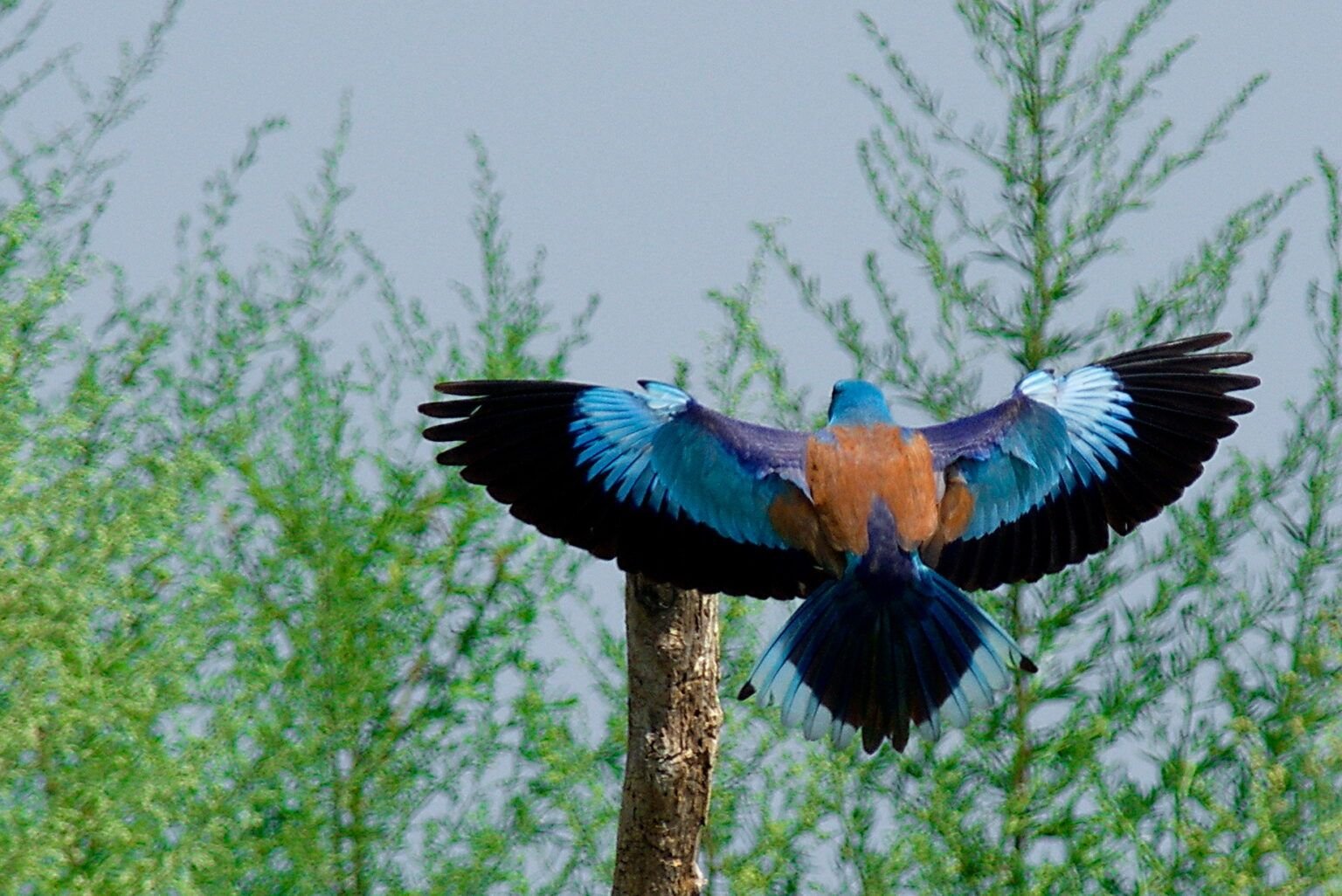The rollers are an Old World family, Coraciidae, of near passerine birds. The group gets its name from the aerial acrobatics some of these birds perform during courtship or territorial flights. Rollers resemble crows in size and build, and share the colourful appearance of kingfishers and bee-eaters, blues and pinkish or cinnamon browns predominating . The two inner front toes are connected, but not the outer one. They are mainly insect eaters, with Eurystomus species taking their prey on the wing, and those of the genus Coracias diving from a perch to catch food items from on the ground, like giant shrikes. Although living rollers are birds of warm climates in the Old World, fossil records show that rollers were present in No.
. The two inner front toes are connected, but not the outer one. They are mainly insect eaters, with Eurystomus species taking their prey on the wing, and those of the genus Coracias diving from a perch to catch food items from on the ground, like giant shrikes. Although living rollers are birds of warm climates in the Old World, fossil records show that rollers were present in No.
The eggs, which are white, hatch after 17–20 days, and the young remain in the nest for approximately another 30 days. Rollers resemble crows in size and build, ranging from 25 to 27 centimetres (10–11 in) in length. They share the colourful appearance of kingfishers and bee-eaters, blues and pinkish or cinnamon browns predominating. The rollers are similar in general morphology to their relatives in the order Coraciiformes, having large heads on short necks, bright plumage, weak feet and short legs. The two inner front toes are connected, but not the outer one. The weakness of the feet and legs is reflected in their behaviour, rollers do not hop or move along perches and seldom use their feet other than for occasional lurching leaps along the ground pursuing escaping prey. The bill is robust, and is shorter yet broader in the genus Eurystomus, sometimes known as the broad-billed rollers.
 The broad-billed rollers have brightly coloured bills, whereas those of the Coracias (or true) rollers are black. Other differences between the two genera are in wing length; the more aerial Eurystomus rollers have longer wings (and shorter feet still) than the Coracias rollers, this reflects differences in their foraging ecology.Their calls are “repeated short, gruff caws”. Distribution and habitat The rollers are found in warmer parts of the Old World. Africa has most species, and is believed to be where the family originated. This is supported by the fact that the related ground-rollers are found on Madagascar. The European Roller is completely migratory, breeding in Europe and wintering in Africa, and the Dollarbird also leaves much of its breeding range in winter. Other species are sedentary or short-range migrants. Rollers are noisy and aggressive when defending their nesting territories, which they patrol while displaying their striking plumage. Intruders are attacked with intimidating rolling dives.
The broad-billed rollers have brightly coloured bills, whereas those of the Coracias (or true) rollers are black. Other differences between the two genera are in wing length; the more aerial Eurystomus rollers have longer wings (and shorter feet still) than the Coracias rollers, this reflects differences in their foraging ecology.Their calls are “repeated short, gruff caws”. Distribution and habitat The rollers are found in warmer parts of the Old World. Africa has most species, and is believed to be where the family originated. This is supported by the fact that the related ground-rollers are found on Madagascar. The European Roller is completely migratory, breeding in Europe and wintering in Africa, and the Dollarbird also leaves much of its breeding range in winter. Other species are sedentary or short-range migrants. Rollers are noisy and aggressive when defending their nesting territories, which they patrol while displaying their striking plumage. Intruders are attacked with intimidating rolling dives.
They are monogamous and nest in an unlined hole in a tree or in masonry, and lay 2–4 eggs in the tropics, 3–6 at higher latitudes. The eggs, which are white, hatch after 17–20 days, and the young remain in the nest for approximately another 30 days. Egg laying is staggered at one-day intervals so that if food is short only the older larger nestlings get fed. The chicks are naked, blind and helpless when they hatch. Coracias rollers are watch-and wait hunters. they sit in a tree or on a post before descending on their prey and carrying it back to a perch in the beak before dismembering it. They take a wide range of terrestrial invertebrates, and small vertebrates such as frogs, lizards rodents and young birds. They will take items avoided by many other birds, such as hairy caterpillars, insects with warning colouration and snakes. 
Eurystomus rollers hunt on the wings, swooping on flying beetles, crickets and other insects which are crushed by their broad deep beaks and eaten on the wing. The Azure Roller and Dollarbird will hunt huge swarms of termites and flying ants which appear after thunderstorms. Tens or hundreds of these rollers may be attracted to large swarms.
in the area of the Danube Delta, several hundred pairs nest, being a very common species from spring to autumn.



